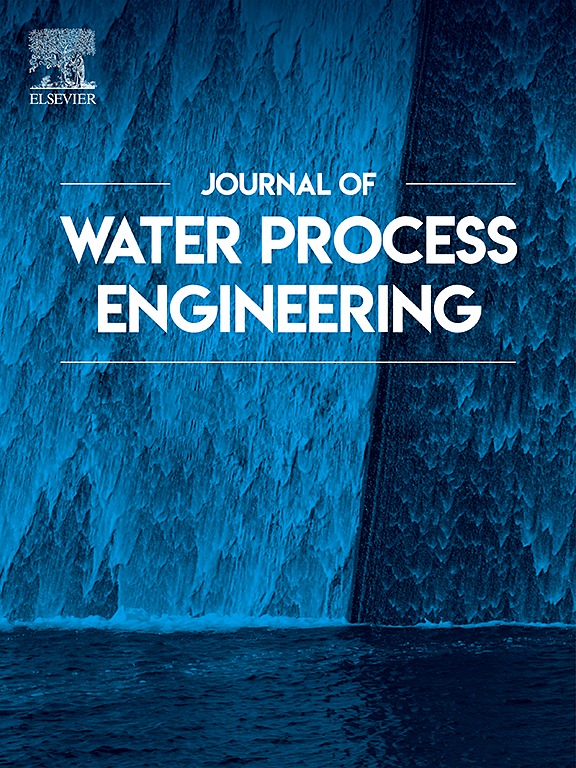UV synergistic magnesium oxide desulfurization waste residue for efficient decoloration of swine wastewater biochemical effluent
IF 6.3
2区 工程技术
Q1 ENGINEERING, CHEMICAL
引用次数: 0
Abstract
The “Pollutant Discharge Standards for Livestock and Poultry Farming” (DB44/613–2024) establishes higher standards for effluent indicators, necessitating deep treatment of swine wastewater to comply with these standards. The prevalent Fenton process, while effective, incurs significant costs and produces substantial sludge volumes. Therefore, an advanced oxidation process utilizing magnesium oxide desulfurization waste residue (MDWR) as a sulfite source was investigated to treat swine wastewater biochemical effluent deeply. The results showed that the decoloration of biochemical effluent by MDWR alone under UV irradiation was low; however, adding Fe(II) significantly enhanced this process. The biochemical effluent's decoloration rate achieved 75.53 % at an initial pH of 5, with 0.6 g/L Fe(II) and 6.0 g/L MDWR. Furthermore, the decoloration efficacy of MDWR was superior to that of Na2SO3 and CaSO3 as sulfite sources. In addition, MDWR can effectively degrade COD, TN, and TP under UV and Fe(II) enhancement so that the effluent can meet the discharge standard. Finally, the quenching experiments, three-dimensional fluorescence, and GC–MS spectra indicated that the decoloration effect of the system primarily resulted from the oxidative degradation of humic acids in biochemical effluent, with SO4•− identified as the most dominant radical. This study predominantly provides an innovative and economical method for deeply treating swine wastewater biochemical effluent.
紫外协同氧化镁脱硫废渣对猪废水生化出水的高效脱色
《畜禽养殖污染物排放标准》(DB44/613-2024)对出水指标制定了更高的标准,需要对养猪废水进行深度处理以符合这些标准。普遍采用的芬顿法虽然有效,但成本高昂,产生的污泥量也很大。为此,研究了以氧化镁脱硫废渣为亚硫酸盐源的深度氧化工艺处理猪废水生化出水。结果表明:在紫外照射下,单用MDWR对生化出水脱色效果较差;然而,添加Fe(II)显著增强了这一过程。在初始pH为5、Fe(II)为0.6 g/L、MDWR为6.0 g/L的条件下,生化出水脱色率达到75.53%。此外,MDWR的脱色效果优于Na2SO3和CaSO3作为亚硫酸盐源。此外,在UV和Fe(II)增强作用下,MDWR能有效降解COD、TN、TP,出水达到排放标准。猝灭实验、三维荧光和GC-MS谱分析表明,该体系的脱色效果主要来自于生化废水中腐植酸的氧化降解,其中SO4•−为最主要的自由基。本研究为养猪废水生化出水深度处理提供了一种创新、经济的方法。
本文章由计算机程序翻译,如有差异,请以英文原文为准。
求助全文
约1分钟内获得全文
求助全文
来源期刊

Journal of water process engineering
Biochemistry, Genetics and Molecular Biology-Biotechnology
CiteScore
10.70
自引率
8.60%
发文量
846
审稿时长
24 days
期刊介绍:
The Journal of Water Process Engineering aims to publish refereed, high-quality research papers with significant novelty and impact in all areas of the engineering of water and wastewater processing . Papers on advanced and novel treatment processes and technologies are particularly welcome. The Journal considers papers in areas such as nanotechnology and biotechnology applications in water, novel oxidation and separation processes, membrane processes (except those for desalination) , catalytic processes for the removal of water contaminants, sustainable processes, water reuse and recycling, water use and wastewater minimization, integrated/hybrid technology, process modeling of water treatment and novel treatment processes. Submissions on the subject of adsorbents, including standard measurements of adsorption kinetics and equilibrium will only be considered if there is a genuine case for novelty and contribution, for example highly novel, sustainable adsorbents and their use: papers on activated carbon-type materials derived from natural matter, or surfactant-modified clays and related minerals, would not fulfil this criterion. The Journal particularly welcomes contributions involving environmentally, economically and socially sustainable technology for water treatment, including those which are energy-efficient, with minimal or no chemical consumption, and capable of water recycling and reuse that minimizes the direct disposal of wastewater to the aquatic environment. Papers that describe novel ideas for solving issues related to water quality and availability are also welcome, as are those that show the transfer of techniques from other disciplines. The Journal will consider papers dealing with processes for various water matrices including drinking water (except desalination), domestic, urban and industrial wastewaters, in addition to their residues. It is expected that the journal will be of particular relevance to chemical and process engineers working in the field. The Journal welcomes Full Text papers, Short Communications, State-of-the-Art Reviews and Letters to Editors and Case Studies
 求助内容:
求助内容: 应助结果提醒方式:
应助结果提醒方式:


